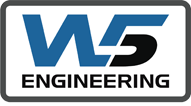Michael Vospernig, one of REVOTEC's two founders, is the company's 'Secretary of the Interior': his main responsibilities include internal procedures and project management as well as the entire development process for automatic bridge monitoring systems, ranging from architecture and measurement technology through to software.
"We're currently working on a project for Austrian Federal Railways (ÖBB) where – for the first time – we're using Weigh In Motion by Kistler to monitor a sensitive road bridge over a railway line and determine the real loads. And the results are successful!"
Michael Vospernig, Co-Founder of REVOTEC
This small bridge is part of the access road to a village located almost in the dead center of Austria. But because there is a large sawmill nearby, the bridge is crossed every day by numbers of trucks carrying heavy loads of timber. 'When the project began in January 2020, there was already some visible damage to the bridge with several cracks in the supporting structure. On behalf of ÖBB, we installed the strain gauges for measurements of the supporting structure in March. Then in May, we added the axle load measurement with the system from Kistler – and that installation was completed within one day, partly because the weather was warm but also thanks to the good instruction manual.'
It comes as no surprise that the bridge monitoring measurements with KiTraffic Statistics show many trucks and tractors with trailers exceeding the overall weight limit of 40 tonnes – sometimes by as much as five or ten tonnes. And it emerged that even vehicles weighing less than 40 tonnes quite often had axle loads of more than 12.5 tonnes, which is the maximum permitted in Austria. 'Thanks to the data acquired, the authorities were able to penalize vehicles weighing over 44 tonnes so as to prevent any further overloading of the bridge – although that couldn't be achieved overnight, because the legal basis for Weigh In Motion is still largely lacking,' Vospernig adds.
High-quality, reliable data
The planned reconstruction of the bridge was also delayed due to unresolved land rights issues: construction is scheduled to start in December 2021. This means that Kistler's WIM system has several important roles to play: reliable classification of vehicles and identification of overloads have now become possible, and changes in the bridge's condition can also be determined more accurately in combination with measurements of the supporting structure. 'The system is efficient to use, and CSV export makes it simple to merge the data with the supporting structure measurements. In this case, the result was an almost linear correlation between the influencing factors and the effects on the supporting structure. Thanks to the high quality and reliability of the bridge monitoring data, this method of long-term measurement could even be applied to other bridges,' Vospernig notes.
Despite some fierce resistance from haulage companies and transporters, the local authorities were ultimately successful in preventing virtually any further overloading of the bridge. Later on, REVOTEC installed a camera system with vehicle numberplate recognition (VNR) in order to extend the 'long arm of the law'. The WIM measurements were backed up by spot measurements using a mobile vehicle weighing system on behalf of ÖBB and in cooperation with the authorities.
Michael Vospernig is highly satisfied with the results, and he can envisage continuing to use KiTraffic Statistics and perhaps other solutions from Kistler in the future. Applications could include projects by ASFINAG (the Austrian Motorway and Expressway Financing Corporation) focusing on traffic data acquisition and bridge monitoring: 'KiTraffic Statistics delivers highly reliable data – the system is simple to set up, and its cost-to-benefit ratio is good. Users can do a lot of the work themselves with the help of the instructions; good contact with Kistler Austria and personal on-site support with the setup were extra benefits.'
Generally speaking, the deployment of WIM technology harbors vast potential for remedying the precarious condition of many bridges in and beyond the DACH region thanks to planning and maintenance based on load data. Instead of making (very conservative) assumptions that force operators to restrict access to bridges or close them in case of doubt, accurately targeted action can now be taken to improve and upgrade them on the basis of real traffic loads. Michael Vospernig agrees with this view, and he goes even further in his final remarks: 'Demand for data-based systems is on the increase. Individual solutions continue to dominate the market at present, but there could be a trend towards modular systems and even turnkey solutions in the medium term. At some point in the future, automated bridge monitoring systems to measure supporting structures and axle loads are likely to become part of the infrastructure: they would allow real-time condition monitoring and predictive maintenance, based on degradation lines and at varying intervals.'




